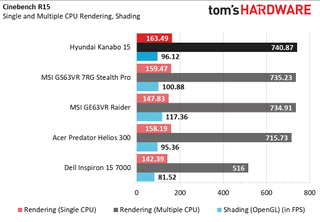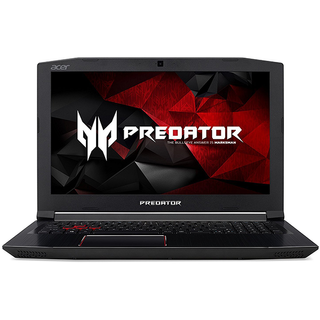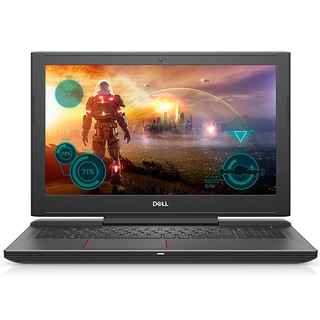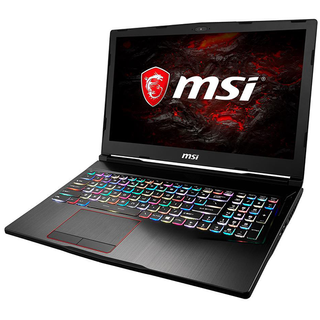Hyundai Kanabo 15 Gaming Laptop Review: Expensive Excellence
Why you can trust Tom's Hardware
Synthetics Benchmarks
The Hyundai Kanabo 15 is the first GTX 1060 laptop we’ve tested in a while. It contains an Intel Core i7-7700HQ, 16GB of DDR4-2400 memory, a 128GB M.2 SSD, a 1TB HDD and a 15.6” Full HD (1920x1080) IPS display. It measures 1.5-inches thick and weighs 6.2 lbs, making it large in comparison to some of the other laptops we’ll be positioning it against.
The Kanabo’s top competitor is undoubtedly the Acer Predator Helios 300, another GTX 1060-based model, which received our pick for Editor’s Choice for its outstanding value and performance. The Acer device contains an i7-7700HQ, 16GB of DDR4-2133 memory, a 256GB M.2 SSD and a 15.6” FHD display. It's available for $100 cheaper than the Kanabo, so the deciding factor between the two comes down to battery life, thermals and display quality.
The Dell Inspiron 15 7000 Gaming is the lowest end system in our roundup and the first laptop we’ve tested with a Max-Q GTX 1060. It's considerably more affordable than the previous two laptops. The device is equipped with an Intel Core i5-7300HQ, 8GB of DDR4 memory, a 256GB M.2 SSD, a 1TB HDD and a 15.6” FHD IPS display. The Inspiron’s performance will provide insight as to whether an energy efficient Max-Q GTX 1060 can compete with its full-fledged variant.
The highest end system in our roundup is the MSI GE63VR Raider. It contains an i7-7700HQ, a standard GTX 1070, 32GB of DDR4-2400 memory, a 512GB M.2 SSD and a 1TB HDD. It also has a 15.6” FHD matte display with a 120Hz refresh rate, allowing it to take advantage of the GTX 1070’s performance in titles where it delivers higher than 60 FPS. The MSI Raider represents the amount of performance gamers can expect from investing nearly double the Kanabo’s price.
Finally, the MSI GS63VR 7RG Stealth Pro will fulfill the high-end portion of our roundup. It contains an i7-7700HQ, a GTX 1070 with Max-Q Design, 16GB of DDR4-2400 memory, a 256GB M.2 SSD and a 1TB 5400 HDD. Like the MSI Raider, it has a FHD anti-glare display with a 120Hz refresh rate. It measures at 0.69” thin and weighs 3.96 lbs, making it the thinnest and lightest system in this comparison.
3DMark



3DMark’s game-like workloads give us a sneak peak of our roundup’s gaming results. The Hyundai Kanabo 15 offers about as much graphical performance as the Acer Predator Helios thanks to their similar configurations. The Kanabo also delivers a fair amount of extra performance over the Dell Inspiron 15 7000 and its Max-Q GTX 1060. We found that the Kanabo’s i7-7700HQ slightly outperformed the rest of the i7-based laptops during the Physics test.
Cinebench R15

3DMark is our main graphical synthetic benchmark, whereas Cinebench measures CPU prowess, particularly the single and multi-core tests. On the other hand, the OpenGL shading test is platform-based, with a slight preference for GPU strength.
We previously mentioned how well the Kanabo’s i7 performed in 3DMark’s Physics tests. It’s CPU goes above and beyond yet again, scoring as much as 15 points higher than the other i7s in both single core and multi-core performance. However, the platform-based OpenGL shading test illustrates the Kanabo’s lack of GPU power in comparison to MSI’s Raider and Stealth Pro.
CompuBench

CompuBench offers a platform-based Video Processing test and a GPU-bound Bitcoin Mining test, which complement our 3DMark benchmarks. In CompuBench, a strong GPU can offset a low-end CPU. The Kanabo delivers similar scores due to their identical configurations, while outperforming the Inspiron 15 by 13 percent and 23 percent in Video Processing and Bitcoin Mining, respectively. The more powerful Stealth Pro and Raider don’t outperform the Kanabo in video processing by much, but offer far more Bitcoin Mining performance.
IOMeter


We perform an IOmeter test on each laptop’s primary drive to measure basic random and sequential read and write speeds. The Kanabo contains a 128GB Phison SM280, the first of its kind that we’ve seen in a gaming laptop. The Acer Helios has a 256GB Micron 1100. MSI utilizes a 256GB and 512GB Samsung PM871 SSD in the Stealth Pro and Raider, respectively. Finally, the Inspiron is equipped with a 256GB Samsung PM961 NVMe SSD.
The Kanabo’s Phison SSD offers the slowest 4K random (QD2) speeds, which is regrettable considering the faster alternatives that competing vendors have sourced. The Phison will launch your favorite applications faster than an HDD, but the experience won’t be as seamless as compared to the Helios or even the Inspiron. It has even slower 128K sequential speeds, which are barely faster than an HDD.
MORE: Best Gaming Laptops
MORE: Gaming Laptop Previews
MORE: All Laptop Content
Current page: Synthetics Benchmarks
Prev Page Introduction & Product Tour Next Page Gaming BenchmarksStay on the Cutting Edge
Join the experts who read Tom's Hardware for the inside track on enthusiast PC tech news — and have for over 25 years. We'll send breaking news and in-depth reviews of CPUs, GPUs, AI, maker hardware and more straight to your inbox.
-
Firion87 Isn't anybody wondering since when does Hyundai build laptops throughout this entire article?Reply -
dxkj21 http://www.eluktronics.com/MECH-15/ This isnt even a new chassis design, the MECH-15 and Im sure others have used this for a whileReply -
-Fran- Ugh... I would love to like this, but I can't.Reply
The Asus GL502VS-FY385T is a 15.6" with a 1070 within striking distance in price and not of the bulk (I have it) shown here. It's more often than not with massive discounts, so if you can shell the extra shekels, by all means get it instead.
Cheers! -
fullauto2009 ne1 paying 1200 bux for a 7700 hq with a 1060 is on drugs. I always lol at how toms advertises tech at way high price points.Reply


